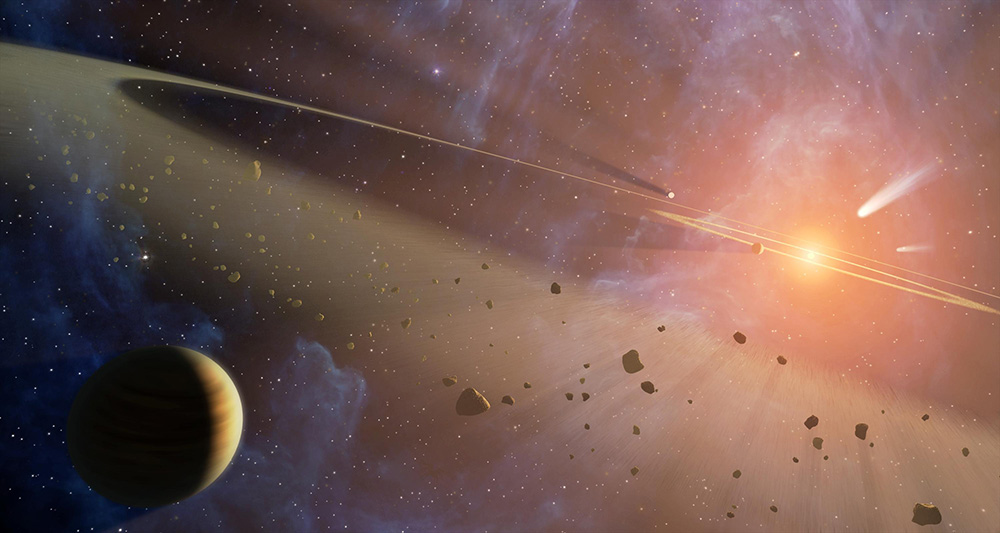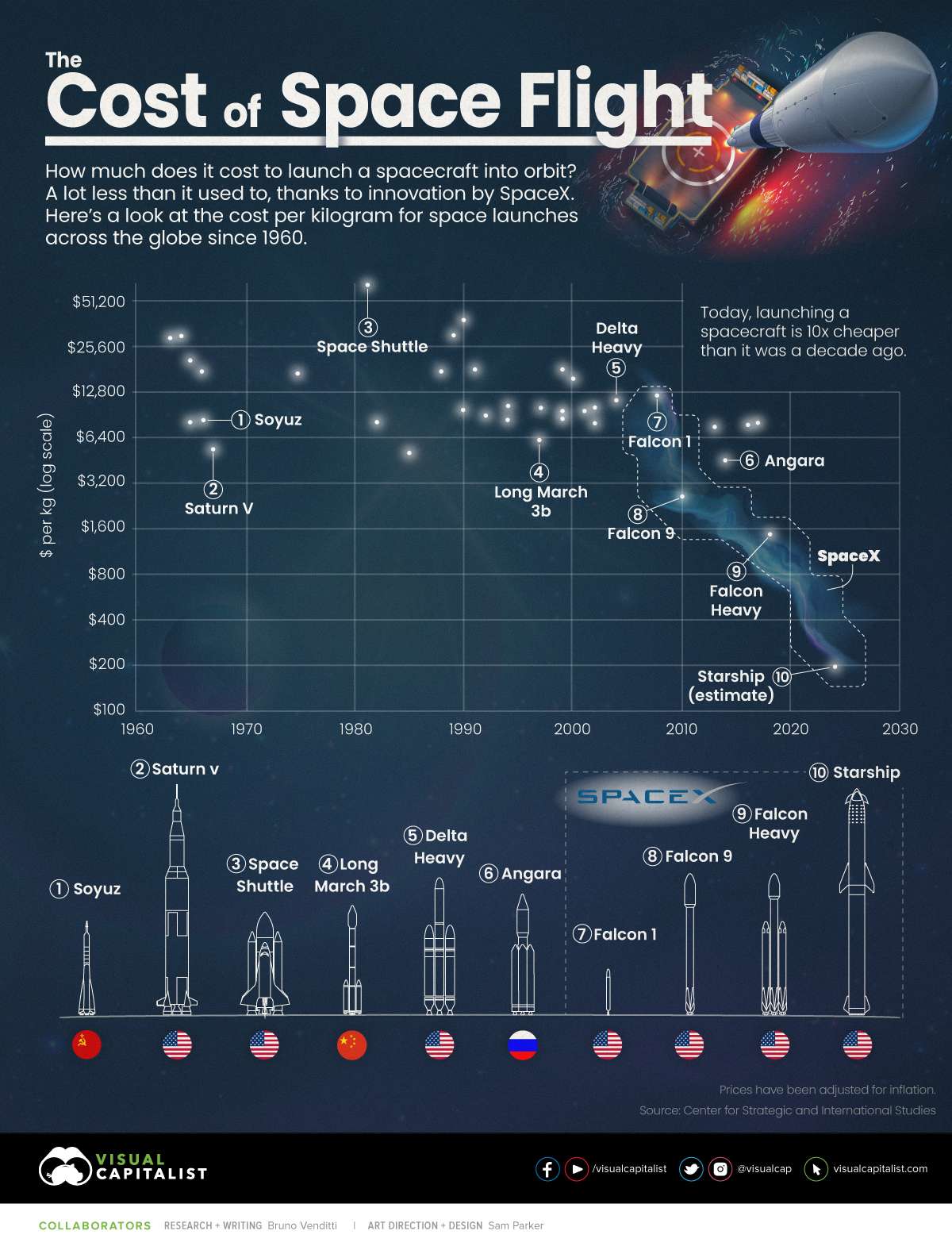Space News and Discussions
-
weatheriscool
- Posts: 13599
- Joined: Sun May 16, 2021 6:16 pm
Re: Space News and Discussions
NASA Set To Reveal Mysterious “Record-Breaking” Hubble Discovery This Week
https://www.iflscience.com/space/nasa-s ... this-week/
https://www.iflscience.com/space/nasa-s ... this-week/
Re: Space News and Discussions
Hubble Spots Most Distant Single Star Ever Seen, at a Record Distance of 28 Billion Lightyears
March 30, 2022
https://www.eurekalert.org/news-releases/948148
Introduction:
March 30, 2022
https://www.eurekalert.org/news-releases/948148
Introduction:
Conclusion:(EurekAlert) With a fortuitous lineup of a massive cluster of galaxies, astronomers from among other institutes the University of Copenhagen and DTU discovered a single star across most of the entire observable Universe. This is the farthest detection of a single star ever. The star may be up to 500 times more massive than the Sun. The discovery has been published today in the scientific journal Nature.
Closeup of the region on the sky, 1/250 of a degree across, where the gravity of a foreground cluster of galaxies magnifies the distant background star — nicknamed Earendil — thousands of times. Credit: NASA/ESA/Brian Welch (JHU)/Dan Coe (STScI)/Alyssa Pagan (STScI).
Gazing at the night sky, all the stars that you see lie within our own galaxy, the Milky Way. Even with the most powerful telescopes, under normal circumstances individual stars can only be resolved in our most nearby galactic neighbors. In general, distant galaxies are seen as the blended light from billions of stars.
But with the marvelous natural phenomenon known as "gravitational lensing", astronomers from the Cosmic Dawn Center at the Niels Bohr Institute and DTU Space were nevertheless able to detect a distance where even detecting entire galaxies is challenging.
"With James Webb, we will be able to confirm that Earendel is indeed just one star, and at the same time quantify which type of star it is,” says Sune Toft, leader of the Cosmic Dawn Center and professor at the Niels Bohr Institute, who also participated in the study. “Webb will even allow us to measure its chemical composition. Potentially, Earendel could be the first known example of the Universe's earliest generation of stars.”
Don't mourn, organize.
-Joe Hill
-Joe Hill
-
weatheriscool
- Posts: 13599
- Joined: Sun May 16, 2021 6:16 pm
Re: Space News and Discussions
Thirteen new pulsars discovered with MeerKAT
https://phys.org/news/2022-03-thirteen- ... erkat.html
by Tomasz Nowakowski , Phys.org
https://phys.org/news/2022-03-thirteen- ... erkat.html
by Tomasz Nowakowski , Phys.org
Using the MeerKAT radio telescope, an international team of astronomers has detected 13 new pulsars in the globular cluster NGC 1851. Twelve of them turned out to be millisecond pulsars (MSPs). The discovery was reported March 23 on the arXiv pre-print server.
Pulsars are highly magnetized, rotating neutron stars emitting a beam of electromagnetic radiation. They are usually detected in the form of short bursts of radio emission; however, some of them are also observed via optical, X-ray and gamma-ray telescopes.
The most rapidly rotating pulsars, those with rotation periods below 30 milliseconds, are known as MSPs. Researchers assume that they are formed in binary systems when the initially more massive component turns into a neutron star that is then spun up due to accretion of matter from the secondary star.
Now, astronomers led by Alessandro Ridolfi of the Cagliari Observatory in Italy, report the finding of another 13 new sources that belong to the pulsar family. The new pulsars were detected in the globular cluster NGC 1851, located some 39,000 light years away, as part of the TRansients And PUlsars with MeerKAT (TRAPUM) Large Survey Project.
-
weatheriscool
- Posts: 13599
- Joined: Sun May 16, 2021 6:16 pm
Re: Space News and Discussions
Blue Origin launches its fourth crew to final frontier
https://phys.org/news/2022-03-blue-four ... ntier.htmlThe New Shepard suborbital rocket blasted off from the company's Launch Site One base in west Texas at 8:58 am local time (1358 GMT) with six crew.
Jeff Bezos' Blue Origin successfully carried out its fourth crewed spaceflight Thursday, a ten-minute joyride beyond the planet's atmosphere and back again.
The New Shepard suborbital rocket blasted off from the company's Launch Site One base in west Texas at 8:58 am local time (1358 GMT) with six crew members.
The crew included Gary Lai, chief architect of the New Shepard program, plus five paying customers—though the ticket price hasn't been disclosed.
"I felt my skin pulling taut," Lai said, of the rocket ride.
Lai's inclusion came after comedian Pete Davidson, the boyfriend of reality star Kim Kardashian, canceled his participation without disclosing a reason.
After launch, the reusable, zero greenhouse gas emissions rocket landed vertically at a pad, while the capsule continued soaring, crossing the Karman line that marks the start of space, 100 kilometers (62 miles) high.
Passengers unbuckled and enjoyed a few minutes of weightlessness, taking in the majesty of Earth before the capsule re-entered the atmosphere, deployed its chutes and floated to the surface for a gentle desert landing.
Re: Space News and Discussions
Where Did the Ice Giant Planets Form?
by Jure Japelj
March 29, 2022
https://skyandtelescope.org/astronomy-n ... nets-form/
Introduction:
Artist’s concept of a young planetary system
NASA / JPL-Caltech
by Jure Japelj
March 29, 2022
https://skyandtelescope.org/astronomy-n ... nets-form/
Introduction:
(Sky & Telescope) Conventional planet formation scenarios have Neptune and Uranus forming closer to the Sun. But a new study shows that the ice giant planets could have formed right where they are now.
Reconstructing the events that led to the present configuration of planets in the solar system is a formidable task. The orderly perennial motions emerged from the hectic conditions within the newborn protoplanetary disk, marked by violent collisions and radial migrations of forming protoplanets. Planet by planet, scientists have tried to put together the pieces of the puzzle. How do Uranus and Neptune, the outermost planets of the solar system, fit in?
The two ice giants are probably the most enigmatic planets in the solar system. Their distances (20 and 30 times the Earth's distance from the Sun, respectively) and unique mass regime (between that of the gas giants and the terrestrial planets) challenge the models. Scientists aren't sure how or where the two planets formed, but evidence has until recently suggested that Uranus and Neptune could not have formed where they are today.
Now, a new study contradicts those arguments, claiming that the planets could, in fact, have formed at their current locations. The intriguing result, to appear in The Astrophysical Journal (preprint available here), provides an alternative to the migration scenario.
"I don't say they didn't form farther in; they could also have formed farther out," says study team member Ravit Helled (University of Zurich, Switzerland). "But we cannot say anymore that they cannot form in situ — yes, they can!"

Artist’s concept of a young planetary system
NASA / JPL-Caltech
Don't mourn, organize.
-Joe Hill
-Joe Hill
-
weatheriscool
- Posts: 13599
- Joined: Sun May 16, 2021 6:16 pm
Re: Space News and Discussions
Elon musk is one of the greatest innovators in space flight in history! If this continues our ability to go to space and to spread could rest on this man.


-
weatheriscool
- Posts: 13599
- Joined: Sun May 16, 2021 6:16 pm
Re: Space News and Discussions
Astrophysicists set constraints on compact dark matter from gravitational wave microlensing
https://phys.org/news/2022-04-astrophys ... ional.html
by Ingrid Fadelli , Phys.org
https://phys.org/news/2022-04-astrophys ... ional.html
by Ingrid Fadelli , Phys.org
The existence of dark matter remains one of the greatest mysteries of the universe. While studies have indirectly hinted at its existence, its invisible nature makes this elusive substance very difficult to detect, thus its composition remains unknown.
Dark matter could be made of fundamental and exotic particles that are yet to be discovered. Alternatively, it could consist of many massive and compact objects, such as primordial black holes (i.e., black holes formed in the early universe).
Over the past decades, many teams of scientists worldwide have been searching for dark matter, using a multitude of techniques, telescopes, detectors and observational data. While most of these searches were unsuccessful, they helped to guide and narrow down subsequent searches.
Researchers at Tata Institute of Fundamental Research's International Centre for Theoretical Studies in Bangalore, India, have recently set new constraints on the fraction of compact dark matter from gravitational wave microlensing. Their paper, published in The Astrophysical Journal Letters, introduces a new way of probing the nature of dark matter by looking for microlensing effects in gravitational waves.
-
weatheriscool
- Posts: 13599
- Joined: Sun May 16, 2021 6:16 pm
Re: Space News and Discussions
The head of Russia's space agency says it is suspending ISS cooperation with NASA and the European S
Source: Business Insider
Space Agency amid Western sanctions
Read more: https://www.msn.com/en-us/news/world/th ... li=BBnb7Kz
Source: Business Insider
Space Agency amid Western sanctions
Russia is suspending its cooperation on the International Space Station (ISS), according to Dmitry Rogozin, head of Russian space agency Roscosmos.
The country will also suspend its partnership with NASA, the European Space Agency (ESA), and the Canadian Space Agency (CSA), Rogozin said.
Newsweek and others first reported the story.
In a series of tweets written in Russian on Saturday, Rogozin said: "I believe that the restoration of normal relations between partners in the International Space Station and other joint projects is possible only with the complete and unconditional lifting of illegal sanctions."
Read more: https://www.msn.com/en-us/news/world/th ... li=BBnb7Kz
-
weatheriscool
- Posts: 13599
- Joined: Sun May 16, 2021 6:16 pm
Re: Space News and Discussions
Confirmed: Pluto Has Gigantic Cryovolcanoes As Tall As the Himalayas
https://www.extremetech.com/extreme/333 ... -himalayas
By Jessica Hall on March 31, 2022 at 1:42 pm
https://www.extremetech.com/extreme/333 ... -himalayas
By Jessica Hall on March 31, 2022 at 1:42 pm
Ever since New Horizons first beamed back its beauty shots of Pluto in 2015, we’ve been poring over the data. Now, planetary scientists have reported evidence confirming the presence of cryovolcanoes on Pluto. The cryovolcanic region borders the southwest aspect of Sputnik Planitia, a brightly reflective, heart-shaped plateau of nitrogen ice.
At up to 7km tall, these enormous mountains of ice are in the height class of the tallest peaks on Earth. Only the Himalayas and Karakoram reach higher. But unlike the craggy peaks of the Himalayas, these cryovolcanoes are like a frozen version of Hawaii’s shield volcanoes. Their shape and mass are like Mauna Loa, with the largest measuring up to 100km wide at the base.